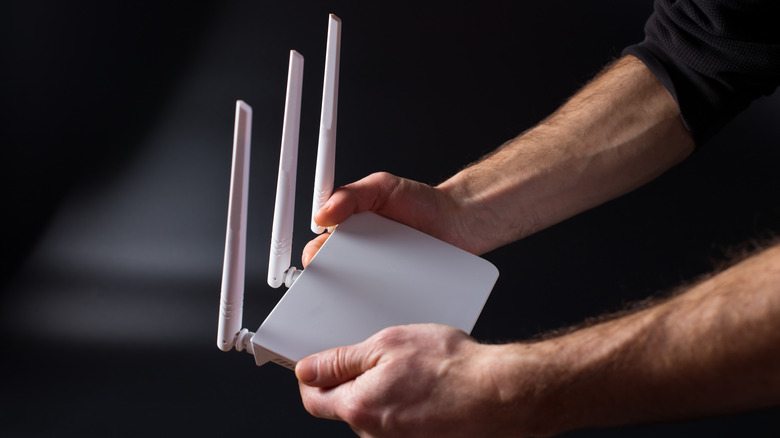3 Signs You May Need A New Wi-Fi Router
Wi-Fi has become a critical part of your home's infrastructure, connecting devices and allowing internet access without hassle. However, a weak or slow connection can lead to frustration and reduced productivity. The quality of your Wi-Fi network depends on several factors, but the router is crucial. Over time, routers can become outdated, leading to decreased performance and speed. If you're experiencing slow internet, frequent disconnections, or poor coverage, it may be time to replace your router.
Slow internet speed is a common issue that is caused by outdated hardware. Routers with limited processing power and obsolete technology can often need help to keep up with the demands of modern devices, resulting in slow internet speed. Upgrading to a new router with upgraded hardware and the latest Wi-Fi standards can boost speed and overall performance.
Frequent disconnections or dropped signals can also signal a problem with your router. Outdated hardware or interference from other electronic devices can cause frequent disconnections, leading to a frustrating user experience. A new router with advanced features like improved interference resistance can help reduce disconnections and maintain a strong and stable connection.
Lastly, poor coverage can indicate that you may need a new router. A weak or non-existent Wi-Fi signal in some regions of your home or office can be due to limited range or outdated technology. New routers with improved range and advanced coverage features can eliminate dead spots and ensure that you have a robust and reliable signal throughout your space.
How to identify if you have a slow internet connection
Slow internet speeds can result from various factors, including outdated hardware, interference from other electronic devices, and network congestion. Identifying if you have a slow internet connection is essential to ensure you get the best performance from your Wi-Fi network.
One of the easiest ways to determine if you have a slow internet connection is to test your speed:
- Ensure you have connected your laptop or mobile device to your home Wi-Fi.
- In your browser, navigate to one of many speed-testing websites like Speedtest.net or Fast.com.
- These tools will automatically measure the speed of your connection and provide you with a report on your download and upload speeds. If your speeds are significantly lower than your internet service provider's advertised speeds, you may have a slow connection.
Another way to determine if your internet speed is slow is to compare it to other devices. If you're using a Wi-Fi connection, try connecting your device directly to the router via an Ethernet cable and run a speed test. If your speeds are faster when connected via Ethernet, your Wi-Fi signal may be to blame. Aging router antennas can cause poor signal.
If you've identified that you have a slow internet connection, it may be time to replace your old router. Upgrading to a newer router with advanced features can boost speed and overall performance.
How to diagnose frequent disconnections or dropped signals
Internet connectivity issues can be frustrating and disrupt daily activities, such as working from home, streaming videos, or playing online games. Understanding the difference between a frequent disconnection and a dropped signal can help identify the cause of the problem and lead to a quicker resolution.
A frequent disconnection occurs when the internet connection is interrupted and re-established multiple times in a short period. Several factors, such as outdated hardware, a weak Wi-Fi signal, or a problem with the internet service provider, can cause this.
- To determine if you are experiencing frequent disconnections, look for symptoms such as slow loading times, buffering when streaming videos, or the inability to connect to the internet.
- You can also check your internet connection by running a network diagnostic tool or resetting your modem and router.
A dropped signal occurs when the internet connection is temporarily lost but quickly reconnects. A problem with the modem, the router, or the internet service provider can cause this.
To determine if you are experiencing dropped signals, look for symptoms such as a sudden loss of internet connectivity, slow page loading times, and frequent buffering when streaming videos. You can also test the signal strength of your Wi-Fi connection and ensure you are close enough to the modem or router. You'll want to look for full or mostly-full bars.
How to identify if you have poor Wi-Fi coverage
Poor Wi-Fi coverage can be frustrating for many people, causing slow internet speeds and dropped connections. If you consistently experience problems related to poor Wi-Fi coverage, consider purchasing a new router.
Dead zones are one of the most common symptoms of poor Wi-Fi coverage. If there are areas in your home where you can't get a Wi-Fi signal, this could indicate that your router or its antennas are on their last legs. However, before purchasing new hardware, you should attempt to move obstacles such as walls, furniture, and other electronic devices away from your router. Moving obstructions can help boost your signal.
You could also move your router to a more central location, update your router's firmware, or add a Wi-Fi extender to boost the signal strength. If none of these solutions work for you, you should start looking for a new router.



